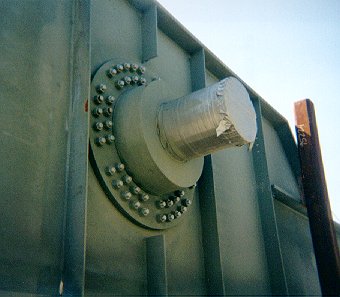DESIGN OF TRUNNION-HUB GIRDER ASSEMBLIES FOR BASCULE BRIDGES
Making new generation of bascule bridges a reality

Home | Grant 1: (98-01) | Grant 2: (01-03) | Grant 3: (04-05) | Pictures | Links |People
|
DESIGN OF TRUNNION-HUB GIRDER ASSEMBLIES FOR BASCULE BRIDGES Making new generation of bascule bridges a reality |
|
|
|
Home | Grant 1: (98-01) | Grant 2: (01-03) | Grant 3: (04-05) | Pictures | Links |People |
||
Headed by Professor Besterfield of Mechanical Engineering and four other faculty members in the College of Engineering, University of South Florida received the following three grants from FDOT to study the trunnion-hub-girder assembly design.
Grant 1: Parametric Finite Element Modeling and Full-Scale Testing of Trunnion-Hub-Girder Assemblies for Bascule Bridges (Year: 1998-2001) We developed Finite Element Analysis (FEA) and experimental models to explain these assembly failures and then use the results to develop specifications for the assembly procedure. Using Ansys, the FEA modeling includes studying transient thermal and mechanical stresses during assembly. It is then followed by full-scale testing of a THG assembly. Specifications and testing requirements for these assemblies are being developed for possible inclusion in American Association of State Highway and Transportation Officials (AASHTO) Specifications.
Grant 2: Hub-girder bolt assembly without an interference fit in bascule bridges (Year: 2001-2003)
From
Grant 1, we found a high probability of
cracks developing in the hub exists when a trunnion-hub assembly is cooled
in liquid nitrogen for shrink-fitting into the girder during one of the
assembly procedures; namely, when the trunnion is shrink fitted into the
hub and then the trunnion-hub assembly is shrink fitted into the girder. To do away with cooling a trunnion-hub assembly, elimination of shrink-fit at the hub-girder is proposed. By eliminating the interference fit at the hub-girder, new problems arise because the bolts now transmit most of the loads from the bridge through the girder, then to the hub (and backing ring), then to the trunnion and finally, to the bearings. For the hub and bolts to now be able to transmit the load, numerous parameters need to be studied and defined or specified. Some of these parameters include: girder thickness, type of bolts (that is, grade and material), bolt sizes, number of bolts, number of bolt circles, bolt material, hub flange thickness, and hub flange diameter, to name a few.
Grant 3: Hub Assemblies for the next generation of bascule bridges (2004-2005) Design of large bascule bridges capable of handling up to four lanes of traffic (and possibly six in the future) brings new challenges that have not been addressed by current design guidelines. Assembly requirements of such designs place constraints on the hub size as well as the type of joint utilized by such hub assemblies. As a result, many of these bridges deviate from current AASHTO and FDOT guidelines on hub geometry as well as hub assembly designs (such as eliminating the shrink fit between the hub and the girder). it is essential to study the impact of deviation from existing requirements on the performance of bridges, with the aim of updating them to provide designers with guidelines for designing the next generation of bascule bridges. |
| Mechanical Engineering| University of South Florida | FDOT | Contact us |
 |